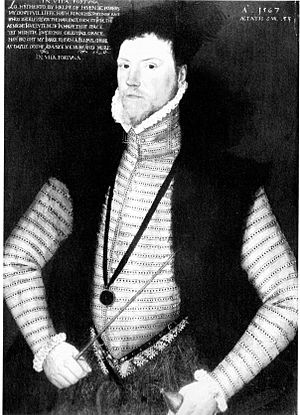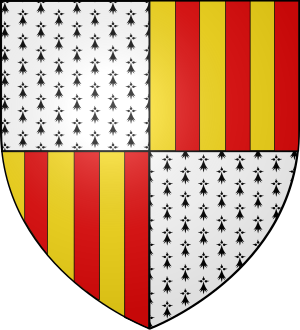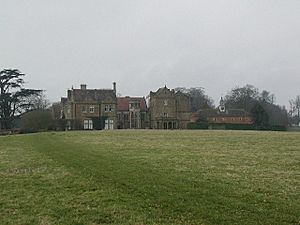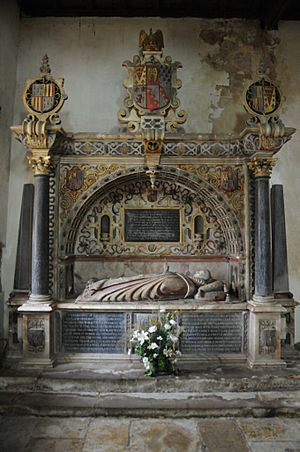Richard Knightley facts for kids
Sir Richard Knightley (born 1533 – died 1 September 1615) lived at Fawsley Hall in Northamptonshire, England. He was a Member of Parliament (MP) and a strong supporter of the Puritans during the time of Queen Elizabeth I. The Knightleys were one of the most important families in Northamptonshire.
Contents
Who Was Sir Richard Knightley?
Sir Richard Knightley was the oldest son of Sir Valentine Knightley and his wife Anne. He took over his father's estate in 1566 and was made a knight in 1565.
Sir Richard's Role in Parliament
Sir Richard served as a Member of Parliament (MP) for different areas. He represented Northampton in 1584 and 1586. Later, he represented Northamptonshire in 1589 and 1598. He also held the important local role of High Sheriff of Northamptonshire twice, from 1568 to 1569 and from 1581 to 1582. In 1587, Queen Elizabeth asked him to be present at the execution of Mary, Queen of Scots, which happened in Northamptonshire.
Supporting the Puritans
Sir Richard Knightley was a well-known member of the Puritan group in Parliament. Puritans were a religious group who wanted to make the Church of England simpler and more "pure."
The Marprelate Tracts
In November 1588, Sir Richard became involved in printing secret pamphlets called the Marprelate tracts. These writings criticized the leaders of the Church of England.
- Starting the Secret Press: In the spring of 1588, a printer named Robert Waldegrave and a Puritan writer named John Penry set up a secret printing press. This was at the home of Elizabeth Hussey in East Molesey, Surrey. The first pamphlet printed there was by John Udall.
- Moving the Press: In late 1588 and early 1589, Waldegrave began printing more controversial writings. These were by an unknown writer using the name Martin Marprelate. The first of these, Martin's Epistle, was printed in October 1588. It became very popular.
- At Fawsley Hall: Because the authorities were looking for Martin, the secret press was moved to Sir Richard Knightley's home at Fawsley in November. Here, Martin's second pamphlet, The Epitome, was printed. Sir Richard might have even paid for the printing costs.
- Further Moves: The press then moved to Whitefriars, Coventry, the home of Sir Richard's great-nephew, John Hales. Two more pamphlets were printed there. After this, Waldegrave stopped printing because some Puritan ministers did not approve of Martin Marprelate's actions. The press then moved again to Wolston Priory in Warwickshire.
Consequences for Sir Richard
The secret press was eventually found in 1589. Sir Richard Knightley was taken into custody but later released. In February 1589, he faced a large fine from the Court of Star Chamber. He was also removed from his roles as a county leader (lieutenancy) and a local judge (magistracy). In 1605, he faced another significant fine.
Later Life and Family
Sir Richard Knightley was also an MP for Orford, Suffolk in 1601. He passed away on 1 September 1615 in Norton, Northamptonshire.
He was married twice:
- His first wife was Mary Fermor. They had three sons and three daughters.
- His second wife was Lady Elizabeth Seymour, who passed away in 1602. She was the daughter of Edward Seymour, 1st Duke of Somerset. With Lady Elizabeth, he had seven sons and seven daughters. Her monument, a special statue, can still be seen in All Saints Church in Norton, Northamptonshire.
Sir Richard's son, Valentine, and his grandson, Richard, also became Members of Parliament, continuing the family's involvement in politics.





